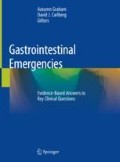Abstract
Antiemetic medications are commonly prescribed in the acute care setting. Most carry a warning for QTc interval prolongation, which may devolve into potentially fatal arrhythmias. Ondansetron, the most commonly prescribed antiemetic, increases the QTc interval by 6–20 ms, which is not sufficient to cause cardiac arrhythmias in most patients. The risk of significant QTc prolongation after receiving an antiemetic drug is significantly associated with preexisting QTc prolongation, electrolyte abnormalities, and organ failure. Patients who are known to have underlying risk factors should have a screening electrocardiogram performed prior to medication administration. Other patients can safely receive a single dose of an antiemetic without any preceding tests.
Access this chapter
Tax calculation will be finalised at checkout
Purchases are for personal use only
References
Cunningham RS. 5-HT3-receptor antagonists: a review of pharmacology and clinical efficacy. Oncol Nurs Forum. 1997;24(7 Suppl):33–40.
Pourmand A, Mazer-Amirshahi M, Chistov S, et al. Emergency department approach to QTc prolongation. Am J Emerg Med. 2017;35(12):1928–33.
Cohen IT. An overview of the clinical use of ondansetron in preschool age children. Ther Clin Risk Manag. 2007;3(2):333–9.
Krammes SK, Jacobs T, Clark JM, Lutes RE. Effect of intravenous ondansetron on the QT interval of patients’ electrocardiograms. Pediatr Emerg Care. 2018;34:38–41.
Moffett PM, Cartwright L, Grossart EA, O’Keefe D, Kang CS. Intravenous ondansetron and the QT interval in adult emergency department patients: an observational study. Acad Emerg Med. 2016;23(1):102–5.
Center for Drug Evaluation and Research. Drug Safety and Availability – FDA Drug Safety Communication: New information regarding QT prolongation with ondansetron (Zofran) [Internet]. U S Food and Drug Administration Home Page. Center for Drug Evaluation and Research; 2012 [cited 26 Oct 2017]; Available from: https://www.fda.gov/Drugs/DrugSafety/ucm310190.htm
Hafermann MJ, Namdar R, Seibold GE, Page RL 2nd. Effect of intravenous ondansetron on QT interval prolongation in patients with cardiovascular disease and additional risk factors for torsades: a prospective, observational study. Drug Healthc Patient Saf. 2011;3:53–8. https://doi.org/10.2147/DHPS.S25623.
Freedman SB, Uleryk E, Rumantir M, Finkelstein Y. Ondansetron and the risk of cardiac arrhythmias: a systematic review and postmarketing analysis. Ann Emerg Med. 2014;64(1):19–25.e6.
Trivedi S, Schiltz B, Kanipakam R, Bos JM, Ackerman MJ, Ouellette Y. Effect of ondansetron on QT interval in patients cared for in the PICU. Pediatr Crit Care Med. 2016;17(7):e317–23.
Moeller JR, Gummin DD, Nelson TJ, Drendel AL, Shah BK, Berger S. Risk of ventricular arrhythmias and association with ondansetron. J Pediatr. 2016;179:118–123.e1.
Goy J-J, Stauffer J-C, Schlaepfer J, Christeler P, editors. Electrolyte disturbances and QT interval abnormalities. In:Electrocardiography (ECG) [Internet]: Bentham Science Publishers; 2013. p. 133–41. [cited 15 Nov 2017]. Available from: http://www.eurekaselect.com/node/112318.
Armahizer MJ, Seybert AL, Smithburger PL, Kane-Gill SL. Drug-drug interactions contributing to QT prolongation in cardiac intensive care units. J Crit Care. 2013;28(3):243–9.
Gaffigan ME, Bruner DI, Wason C, Pritchard A, Frumkin K. A randomized controlled trial of intravenous haloperidol vs intravenous metoclopramide for acute migraine therapy in the emergency department. J Emerg Med. 2015;49(3):326–34.
Barni S, Petrelli F, Cabiddu M. Cardiotoxicity of antiemetic drugs in oncology: An overview of the current state of the art. Crit Rev Oncol Hematol. 2016;102:125–34.
Smith HS, Cox LR, Smith BR. Dopamine receptor antagonists. Ann Palliat Med. 2012;1(2). [Internet]. [cited 1 Jan 2012]; Available from: http://apm.amegroups.com/article/view/1039
Malik IA, Khan WA, Qazilbash M, Ata E, Butt A, Khan MA. Clinical efficacy of lorazepam in prophylaxis of anticipatory, acute, and delayed nausea and vomiting induced by high doses of cisplatin. A prospective randomized trial. Am J Clin Oncol. 1995;18(2):170–5.
Goodnick PJ, Jerry J, Parra F. Psychotropic drugs and the ECG: focus on the QTc interval. Expert Opin Pharmacother. 2002;3(5):479–98.
Author information
Authors and Affiliations
Corresponding author
Editor information
Editors and Affiliations
Rights and permissions
Copyright information
© 2019 Springer Nature Switzerland AG
About this chapter
Cite this chapter
Kean, E.R., Hinton, M., Roepke, C. (2019). When Should QT Prolongation Be Considered in Antiemetic Use?. In: Graham, A., Carlberg, D.J. (eds) Gastrointestinal Emergencies. Springer, Cham. https://doi.org/10.1007/978-3-319-98343-1_38
Download citation
DOI: https://doi.org/10.1007/978-3-319-98343-1_38
Published:
Publisher Name: Springer, Cham
Print ISBN: 978-3-319-98342-4
Online ISBN: 978-3-319-98343-1
eBook Packages: MedicineMedicine (R0)

